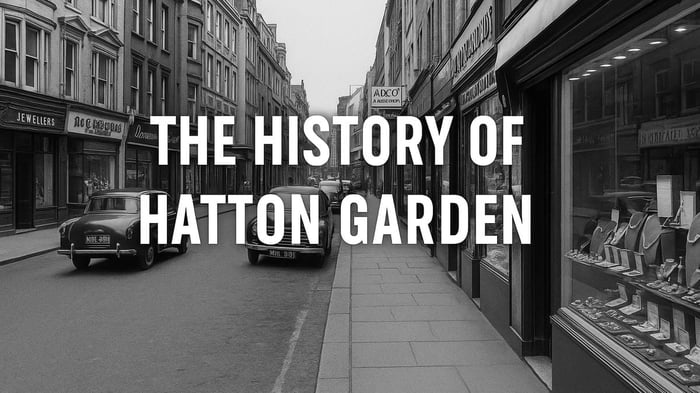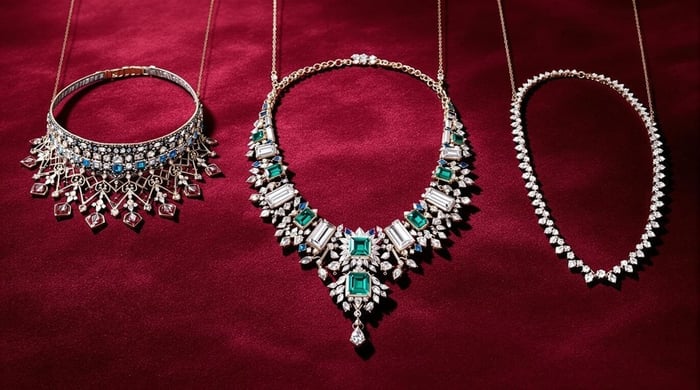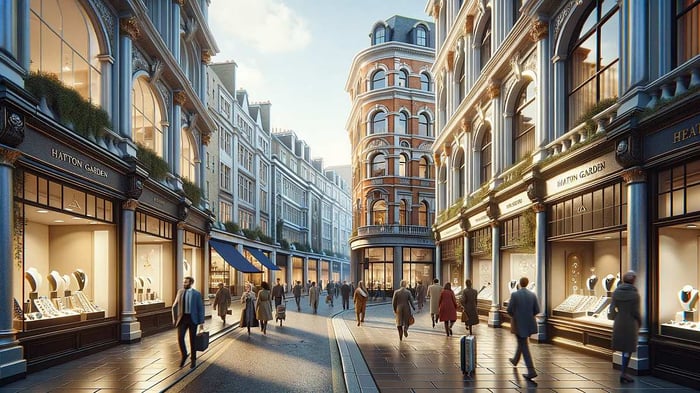Table of Contents
- Article Summary Of The History Of Hatton Garden
- Medieval Origins and Elizabethan Transformation
- Restoration-era Housing and Early Development
- Rise of the Jewellery Trade in the 19th Century
- The Peak of the Diamond Trade in 1885
- 20th Century Growth and Global Influence
- Modern-Day Legacy and Adaptation
- Our Final Thoughts
- From History to Modern Elegance
Hatton Garden, a name synonymous with glittering diamonds and skilled craftsmanship, has a history as affluent as its offerings. The history of Hatton Garden dates back to its origins as part of the Bishop of Ely's medieval estate, before transforming into a prestigious area under Sir Christopher Hatton in the Elizabethan era. By the 19th century, it had become a thriving hub for the jewellery trade, famed for its luxury goods. Today, it continues to merge tradition with cutting-edge technology. But how did it all begin?
Article Summary Of The History Of Hatton Garden
- Hatton Garden's origins can be traced back to medieval times as part of the Bishop of Ely's estate, renowned for its strawberry orchards.
- The area underwent transformation during the Elizabethan era under Sir Christopher Hatton, attracting affluent residents and laying its prestigious foundations.
- The jewellery trade of the 19th century turned Hatton Garden into a hub for luxury goods, capitalising on diamond imports from the East India Company.
- By 1885, Hatton Garden had become London's diamond trade centre, with a network of specialists in stone-cutting and craftsmanship.
- Modern Hatton Garden integrates tradition with technology, featuring over 300 businesses employing sustainable practices and advanced production techniques.
Medieval Origins and Elizabethan Transformation
Although Hatton Garden might be famous today for its lively jewellery trade, its roots stretch back to medieval times as part of the Bishop of Ely's estate.
Situated between Leather Lane and Holborn, medieval agriculture thrived here, especially with its luscious strawberry orchards. This area’s history, steeped in traditions where trades clustered for ease, predates the Elizabethan influence.
Medieval agriculture thrived with luscious strawberry orchards, predating Elizabethan influence in this historically rich area.- Elizabethan Transformation: Sir Christopher Hatton, a favourite of Queen Elizabeth I, significantly impacted the area in 1570.
- Land Acquisition: In 1581, Hatton received a permanent grant of Ely Place, shaping the future Hatton Garden. Named after Sir Christopher Hatton, the district's development as a residential area attracted wealthy individuals and laid the groundwork for its current status as a prestigious locality.
His influence endowed the district with a legacy intertwined with royal favour and strategic land development, transforming it from fertile grounds to a name synonymous with history and prestige.
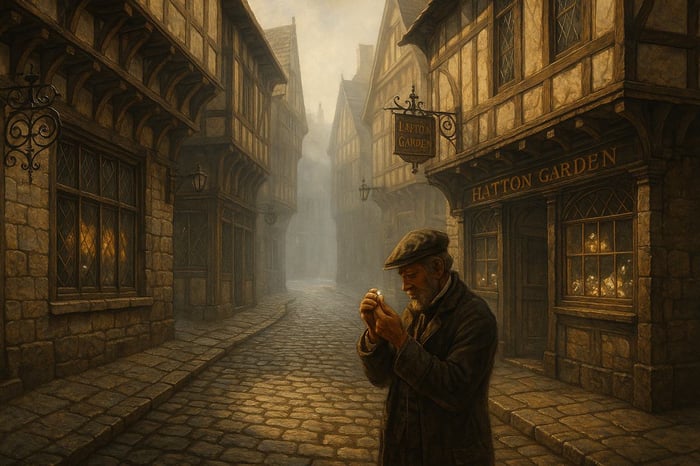
Restoration-era Housing and Early Development
During the Restoration era, Hatton Garden underwent significant transformation, shifting from mediaeval origins to a vibrant residential hub. The construction of Hatton House marked the beginning of this change, as Baron Hatton and other royalist elites returned to London, eager to build over the former Bishop of Ely's gardens. This post-war housing boom saw the rise of brick buildings and grid street layouts, echoing the urban planning seen in Covent Garden, and attracting wealthy merchants and legal professionals to the area. The area further evolved to become a global centre for diamond trading, underlining its lasting cultural and economic significance.
Medieval Origins
Hatton Garden's deep-rooted medieval roots marked a new chapter during the Restoration era. The Bishops of Ely held the area, originally known as the Ely Estate, which boasted stunning medieval architecture with distinct ecclesiastical influences. This historical backdrop set the stage for later urban development.
- Ely Estate origins: Owned by Bishops of Ely, boasting palaces and gardens.
- Post-Civil War changes: Returned to Christopher Hatton, a key Royalist, in 1646.
- Restoration-era urbanisation: Modelled after Covent Garden, attracting affluent residents.
The shift from an ecclesiastical estate to a thriving residential area reflects London's dynamic evolution. Today, Hatton Garden stands as an iconic commercial district renowned for its jewellery trade, exemplifying the enduring resilience of London's changing landscape.
Hatton Garden's enduring appeal lies in its ability to merge historical allure with modern prosperity, creating a community abundant in heritage.
Collar de diamantes G/SI de 1,55 quilates y 0,35 quilates con halo de tanzanita en oro blanco de 18 k

€1.386,95
Un sorprendente halo de diamantes cortados a mano y de origen ético rodea un quilate y medio de tanzanita exótica y acentúa su belleza azul profundo. Este collar será una adición encantadora a la colección de su ser querido y… read more
Hatton House Construction
Hatton Garden's transformation during the Restoration era began with the construction of Hatton House, which marked a significant shift in urban development. This transformation saw the land change from ecclesiastical grounds to aristocratic housing.
Sir Christopher Hatton's acquisition of the site laid the groundwork for urban planning innovations. The grid-like street pattern stood out in London's medieval layout, offering affluent residents proximity to the legal district and the emerging West End. During this time, the area also saw an influx of jewellers and tradesmen, which changed the area’s character significantly.
- Architectural Styles: Hatton House reflected Dutch-influenced post-Fire designs, merging Restoration-era elegance with modernity.
- Urban Planning: Strategic location between Holborn and the West End, incorporating Ely Palace orchards into the design.
- Social Context: Targeted royalist aristocracy returning post-exile, showcasing private land ownership over church-held lands.
Post-War Housing Boom
The post-war housing boom in Hatton Garden marked a significant chapter in London's history. This era was characterised by housing innovations and urban renewal to address the city's pressing housing needs. British post-war architecture stood out for its experimentation and the introduction of new materials, transforming Hatton Garden's environment. Urban renewal efforts in areas like Holborn played an essential role in this transformation, spurred by government policies aimed at rebuilding the city. The post-war housing crisis in the UK, exacerbated by bombing devastation and material shortages, highlighted the urgency of these redevelopment initiatives.
- Housing Innovations: New construction techniques emerged, reshaping building designs.
- Urban Renewal: Redevelopment tackled housing shortages and revitalised neighbourhoods.
- Mixed-Use Developments: Buildings combined residential, retail, and workshop spaces.
Hatton Garden's evolution during this time wasn't just about bricks and mortar; it was about creating a community that resonated with people's need for belonging.
Rise of the Jewellery Trade in the 19th Century
In the early 19th century, Hatton Garden was a prestigious residential district, but it was the burgeoning jewellery trade that truly transformed the area.
With the influence of wealthy residents, the demand for luxury goods such as jewellery skyrocketed. This growth encouraged exceptional jewellery craftsmanship, laying the groundwork for Hatton Garden's reputation.
- Initial Growth: By 1836, about 13 jewellery-related businesses had taken root, hinting at the area's potential.
- Influential Neighbours: Nearby Clerkenwell's established jewellery hub provided a solid foundation.
- Economic Impact: The East India Company’s diamond imports boosted the trade.
- Community Spirit: The presence of affluent merchants and officials contributed to a thriving, interconnected community, uniting residents and traders in their pursuit of luxury. The jewellery trade began to flourish in Hatton Garden in the 19th century, marking the start of a longstanding tradition in the area.
The Peak of the Diamond Trade in 1885
In 1885, Hatton Garden reached the pinnacle of its diamond trade, boasting a prestigious network of 67 merchants acknowledged globally for their expertise. These merchants utilised global supply routes, particularly from South Africa's Kimberley diamond fields, to fuel their thriving businesses. With craftsmanship at its core, the area became famous for its skilled artisans who transformed raw diamonds into exquisite jewellery, cementing Hatton Garden’s status as a world-class jewellery hub. Additionally, the machine gun was invented in Hatton Garden in 1881, highlighting the area's contribution to both military and commercial innovations.
Prestigious Merchant Network
Although many cities have laid claim to the crown of diamond trading, Hatton Garden shone especially brightly in 1885 as London's undisputed treasure in the crown of commerce. This prestigious merchant network thrived on influential partnerships, forming the backbone of the area's economic strength. Known as the UK’s diamond trade centre, Hatton Garden was home to a vibrant mix of traders and customers, which contributed to its reputation.
The lively community was a hub of:
- Localised expertise: Specialists in stone-cutting and appraisals guaranteed quality.
- Cross-industry collaborations: Stone dealers, silversmiths, and engravers worked seamlessly together.
- Formalised partnerships: Ties with global mining operations secured raw materials.
Upper-tier dealers wielded immense merchant influence, orchestrating the flow of Kimberley Diamonds from South Africa. Their intergenerational businesses, steeped in tradition, maintained a high concentration of skilled artisans.
This harmonious mix of expertise and innovation crowned Hatton Garden as London's diamond heart.
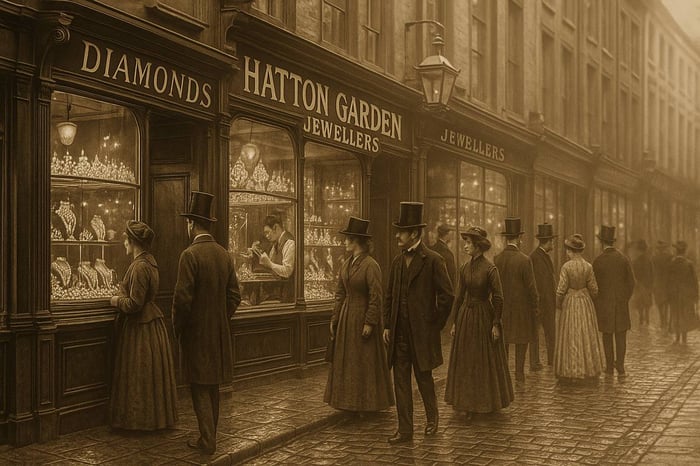
Global Supply Routes
During the peak of the diamond trade in 1885, Hatton Garden stood as a lively epicentre of global supply routes. This vibrant hub thrived on dynamic market dynamics, with around 67 precious stone merchants calling it home. Hatton Garden's strategic location near the City of London and the improved road systems made it a key player in diamond distribution. Its transformation into a commercial centre was marked by the development of new buildings and adaptations of existing ones, which enhanced its capacity to handle large-scale diamond imports. In 1881, Sir Hiram Maxim established a small factory in Hatton Garden, which contributed to the area's industrial history and innovation. The diamond mining process was crucial in supplying the raw materials that fuelled the booming jewellery trade.
- Global Influence: Hatton Garden became a dominant force, shaping worldwide supply routes.
- De Beers Connection: With De Beers nearby, its impact on global diamond trade grew.
Hatton Garden's reputation for quality and authenticity cemented its status as London's jewellery capital.
Aretes Halo de Diamantes 0.55ct Calidad G/SI en Oro Blanco 18k

€1.305,95
Estos hermosos aretes hechos a mano cuentan con un halo de brillantes diamantes redondos creados en laboratorio que enmarcan elegantemente el diamante central creado en laboratorio. Con cuatro diminutas piedras de diamantes para complementar el diamante principal, el conjunto se… read more
Craftsmanship and Expertise
As Hatton Garden buzzed with global trade activity, the district became a beacon of craftsmanship and expertise. By 1885, it was the heart of London’s diamond craftsmanship, with 67 precious stone merchants transforming the area into a hub of artisan techniques.
The skilled workforce, including lapidaries, stone-cutters, and engravers, honed precision cutting and setting methods, guaranteeing Hatton Garden's global recognition.
- Apprenticeships thrived, standardising training and preserving the artistry for future generations.
- Proximity to De Beers allowed quick access to raw materials, boosting production efficiency.
- Watchmakers' expertise contributed intricate metalwork skills, elevating the jewellery quality.
Buyers relied on trust networks, cultivating a community built on reputation, where every creation told a story of dedication and mastery. As Hatton Garden continued to evolve, approximately 300 jewellery businesses and 55 jewellery shops currently operate, offering both modern and vintage designs, ensuring the district remains a pivotal centre of the jewellery trade.
20th Century Growth and Global Influence
Hatton Garden's transformation in the 19th century marked a pivotal era of industrial expansion and global influence. In 1881, Sir Hiram Maxim launched a factory at 57 Hatton Garden, producing the groundbreaking Maxim Gun. This move showcased the area's industrial prowess. As the century progressed, Hatton Garden shifted its focus from general metalwork to specialised jewellery and precious stone trades. Additionally, the area's growth in the diamond industry prompted the need for insurance policies to protect valuable investments.
- Infrastructure Growth: Underground vaults and tunnels emerged, enhancing secure storage and manufacturing.
- De Beers’ Influence: Leveraging discoveries from the Kimberley Diamond Rush, De Beers established Hatton Garden as a key diamond trading hub.
Modern-Day Legacy and Adaptation
As the world moves towards digitalisation, Hatton Garden stays true to its roots, merging tradition with technology in a constantly changing jewellery industry.
Over 300 businesses thrive here, combining sustainable practices with technological innovations. They continue to captivate a global audience by offering:
- Specialist workshops for bespoke designs and repairs
- Advanced workshops using CAD software and 3D printing
- Certification systems guaranteeing ethical sourcing and traceability
Hatton Garden remains a beacon for those pursuing connection to an illustrious heritage. With establishments such as Jade Jewellers offering both contemporary and classic fine jewellery, the district exemplifies a unique blend of tradition and modernity.
Its collaborative ecosystem between artisans and retailers cultivates a sense of belonging.
As rising rents and online competition pose challenges, the district's commitment to sustainable practices and innovation secures its status as a cherished societal landmark endures.
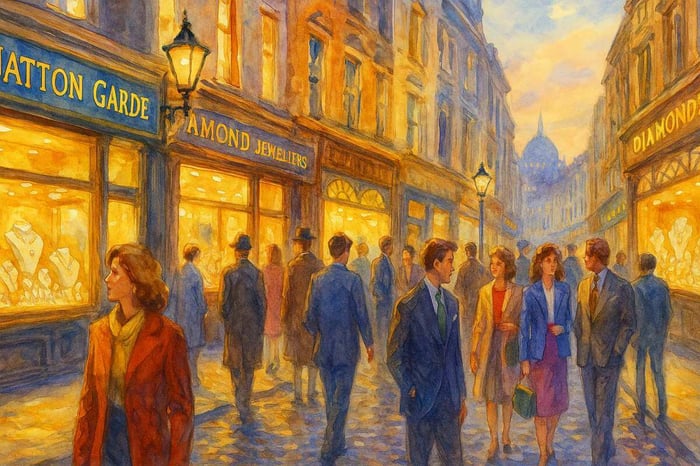
Our Final Thoughts
Hatton Garden stands as a glittering fabric woven with history, innovation, and resilience. Its medieval roots and Elizabethan allure merge seamlessly with today's state-of-the-art technology. "Hatton Garden is a reflection of tradition meeting modernity," said a local jeweller. The district's legacy shines brightly, much like the diamonds it houses, reflecting a world of craftsmanship and global influence. Here, the past and present sway in harmony, securing its place in London's lively cultural environment.
Anillo de compromiso con solitario de diamante certificado de 1,00 ct de oro amarillo de 18 quilates de calidad E/VS

€5.902,95
Nuestro anillo de compromiso con solitario acentúa elegantemente la piedra central con una banda amarilla de 18k. Este hermoso anillo hecho a mano en oro amarillo de 18k presenta diamantes éticos de calidad E/VS y pesa un total de 1,00… read more
From History to Modern Elegance
As we journey from the history of Hatton Garden with its rich past to today’s thriving diamond trade, the legacy of craftsmanship lives on in every brilliant piece.
At All Diamond, you’ll discover a stunning collection of natural diamond jewellery, each piece designed and handcrafted in the United Kingdom by skilled artisans. With a lifetime workmanship guarantee, you can buy with confidence, knowing you’re investing in exceptional quality and timeless beauty.
Explore the All Diamond collection today — where heritage meets modern luxury.
